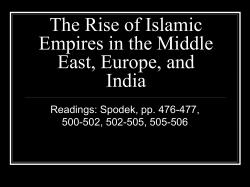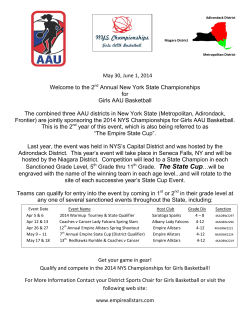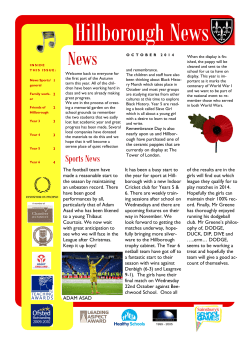
Unit 4 Study guide NEW sp15
AP World History Unit 4 Study Guide Global Interactions (c. 1450 to 1750 CE) Each of the following sections contains relevant terms and questions to guide your studies for the upcoming unit test. Be able to identify the terms listed and analyze their significance within the appropriate context. Please be aware that this study guide is a starting place, not an exhaustive list of all the potential terms and concepts from this unit. Ottoman Empire Kayi Turks Seljuk Turks Anatolia Osman I sipahi janissaries muskets / cannons slavery Mehmed II 1453 Istanbul Suleiman I Battle of Vienna harem Grand Vizier pashaliks / pashas millet jizya Sunni Islam Guiding Questions: 1. What policies of religious tolerance or integration were used in governing the Ottoman Empire? 2. What or who were the janissaries? What was their purpose? 3. Explain the social, economic, legal, and military accomplishments of Suleiman the Magnificent. 4. The Ottoman Empire will endure until the twentieth century. What, in your opinion, allows the Empire to survive for so long? ______________________________________________________________________________________________________ Safavid Empire Azerbaijan Sufism Shi’a Islam red heads Persia Shah Ishmael I Shah ‘Abbas I Baghdad Mamluks Isfahan meritocracy Caspian Sea trade textile production Uzbek tribes Guiding Questions: 1. In what ways did Shi’a Islam inform the policies and practices of the Safavid Empire? 2. How did the Safavid Empire’s ongoing conflict with the Ottoman Empire affect trade routes and economic practices in the region? 3. How did the spread of firearms affect the Safavid Empire and its relationship with nearby empires? ______________________________________________________________________________________________________ Mughal Empire Delhi Sultanate Babur Abu Akbar religious tolerance Sunni Islam Hinduism Mansabdars Sulh-e-Kul Din-i-Ilahi Purdah sati Vaishyas Jahangir Nur Jahan Mumtaz Mahal Shah Jahan Taj Mahal Aurangzeb “Islamization” Jesuit presence Mumbai British East India Company Dutch East India Company Guiding Questions: 1. Explain Akbar’s views and policies regarding religious tolerance and syncretism. 2. What were some of the factors that led to the decline of the Mughal Empire? Be sure to consider increasing global connections. 3. Compare and contrast the religious policies of Akbar and Aurangzeb. What are some similarities? What are some differences? 4. What evidence do you see of increasing global connections in the politics, culture, economic system, and social order of the Mughal Empire? ______________________________________________________________________________________________________ Ming Dynasty “treasure fleet” Indian Ocean Portuguese traders Macao Ming Hongwu Beijing Forbidden City Zheng He Jesuits American silver Li Zecheng Manchus porcelain silk compass isolationism Guiding Questions: 1. Consider the seven voyages of Zheng He. What prompted the Ming dynasty to end China’s brief flirtation with exploration and international trade? 2. What factors led to the downfall of the Ming dynasty? ______________________________________________________________________________________________________ Qing Dynasty Kangxi queue Qianlong Jesuit missionaries diarchy system White Lotus Rebellion Russia Mongolia Canton Guiding Questions: 1. What was the social significance of the queue worn by Chinese men during the Qing dynasty? 2. Both the Qing and the Yuan dynasties were “foreign” dynasties from the north. Beyond their common geographic roots, what are some similarities between the Qing and Yuan dynasties? Consider their social organization and political structure. ______________________________________________________________________________________________________ Japan: Unification and Isolation shogun shogunate Kamakura Shogunate Ashikaga Shogunate Sengoku (Warring States Period) Daimyos Portuguese presence Francis Xavier Oda Nobunaga Toyotomi Hideyoshi “Sword Hunt” martial arts land-survey program four-class system Jesuit missionaries Christianity Korea Tokugawa Ieyasu Edo alternate attendance geishas Dutch presence Nagasaki harbor Guiding Questions: 1. Describe the transition between the Ashikaga Shogunate and the Tokugawa Shogunate. Be sure to include the Warring States Period and the three military unifiers. 2. What was the Japanese reaction to Christianity? In what ways was Christianity seen as a threat by some Japanese leaders? 3. What prompted the Japanese move towards isolationism in the 17th and 18th centuries? ______________________________________________________________________________________________________ Early Russian Empire Khanate of the Golden Horde Kiev Dniepper River Novgorod Moscow Mongols Ivan III (the Great) tsar (czar) Ivan IV (the Terrible) Caspian Sea trade Oprichniki boyars St. Basil’s Cathedral Time of Troubles Ivan Tsarovich volcanic eruption famine Romanovs Mikhail Romanov Peter the Great Westernization St. Petersburg warm water port Black Sea Elizabeth the Great Winter Palace beard tax Catherine the Great serfdom Enlightenment educational reforms Guiding Questions: 1. Why was Ivan IV “terrible?” What changes did he make to rulership in Russia during the late 15th and early 16th centuries? 2. How did Peter the Great’s insistence on access to a warm water port alter Russia’s involvement with Western Europe? 3. What constraints did Catherine the Great experience with regards to her personal power? Italian and Northern Renaissance Florence Venice Milan Papal States Naples Medici’s banking textile guilds Florentine gold (florins) humanism humanities Petrarch Erasmus individualism capitalism Gutenberg’s printing press moveable type skepticism secularism Niccolo Machiavelli The Prince Pope Alexander VI Cesare Borgia Leo X Indulgences Lorenzo de’ Medici “Renaissance Man” Leonard da Vinci perspective fresco Sistine Chapel Last Judgment David La Pieta Michelangelo Guiding Questions: 1. How was the Renaissance different from the Middle Ages? Consider: intellectual movements, social order, government structures, religious practices, and economic systems. 2. Describe the role banking played in the rise of Florence during the Italian Renaissance. 3. What is a “Renaissance Man?” 4. Describe the effect that thinkers like Machiavelli, Erasmus, Petrarch, Luther, Gallileo, and da Vinci had on European society. 5. The popes from the early Renaissance period have been called the “Terrible Popes.” Consider their religious policies, their political roles, and their contributions to Renaissance cultural production. 6. What were some of the significant artistic achievements of this period? ______________________________________________________________________________________________________ Reformation and Counter-Reformation Martin Luther Ninety-Five Theses Lutheranism Protestantism celibacy education Jesuits Ignatius Loyola John Calvin Calvinists predestination vernacular Henry VIII Anglicanism Act of Supremacy Mary I Elizabeth I annulment Anne Boleyn Catherine of Aragon Huguenots Council of Trent indulgences salvation through faith good works sacraments Index of Prohibited Books Inquisition Guiding Questions: 1. How is the Protestant Reformation an expression of Renaissance values? In what ways is it a repudiation of those values? 2. Explain the role of Henry VIII in the English Reformation. 3. What were some of the major critiques of the Catholic Church at the time of the Protestant Reformation? What were some of the ways in which the Catholic Church responded to these critiques? 4. What was the outcome of the Council of Trent? (What was changed in the Catholic Church? What was reaffirmed?) ______________________________________________________________________________________________________ Exploration and Conquest Prince Henry the Navigator Vasco da Gama trade ports Christofolo Colon Hispaniola West Indies 1492 1519-1521 caste system New Spain Peru Columbian Exchange trans-Atlantic slave trade triangular trade conquistadors peninsulares creoles mestizo mulato Price Revolution Treaty of Tordesillas Line of Demarcation encomienda system Council of the Indies Viceroy Virgin of Guadalupe Bartolomé de las Casa “New Laws” sugar plantations slavery Middle Passage Philippines disease smallpox Guiding Questions: 1. What was the encomienda system, and what was its intended purpose? 2. Explain the caste system used in Spain’s colonies. How did it reinforce (or fail to reinforce) social order? 3. What was the role of the Catholic Church during exploration? 4. What factors led to the increased reliance on African slavery in the Americas? 5. Who was Bartolomé de las Casas, and what did he do? 6. What is the general order of events which leads to permanent colonization?
© Copyright 2025














